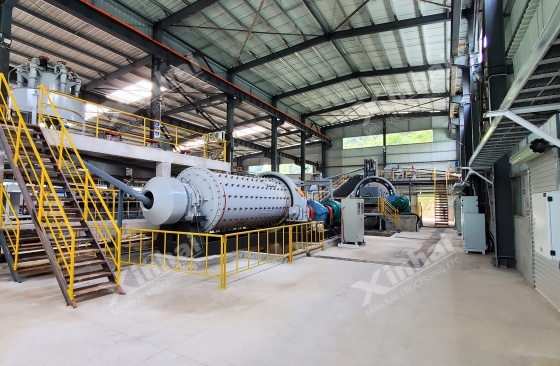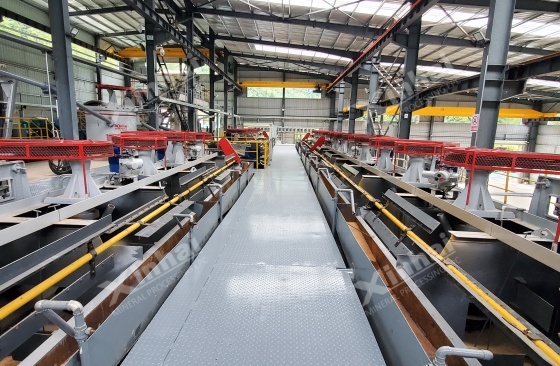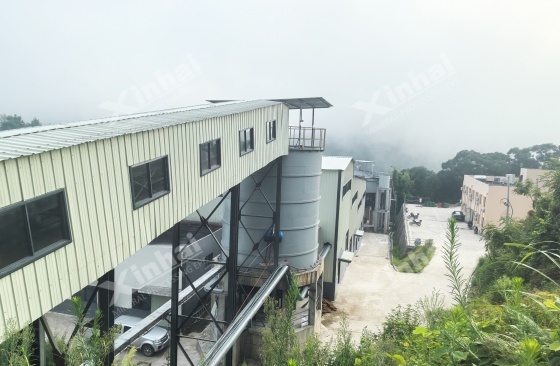If you want to know more information (such as product/process price, etc.), please contact us 24-hour telephone
Fluorite is an important strategic resource. Pure fluorite ores are rare; most fluorite deposits are associated with other minerals, and antimony-bearing fluorite is one such type. Antimony is widely used in flame retardants, alloy materials, and other fields, while fluorite is a key raw material in the fluorine chemical industry chain. In processing antimony-containing fluorite, how can resource waste be minimized and the comprehensive recovery of these two valuable elements be achieved? This article will explain the detailed process flow.
The primary valuable minerals in the ore are stibnite and fluorite. The stibnite (Sb₂S₃) content ranges from 3–5%, with an embedded particle size of 0.05–0.3 mm. Fluorite content ranges from 40–65% and is associated with gangue minerals such as calcite and quartz. The ore also contains antimony oxides, pyrite, and other minerals. It exhibits a fine veinlet impregnation structure, with complex intergrowth of stibnite and fluorite, making separation difficult.

1. Crushing and Grinding
The raw ore undergoes two- or three-stage crushing using a jaw crusher and a cone crusher to reduce the particle size to below 15 mm. It is then ground in a ball mill. A stage grinding and classification process is used, with two grinding stages:
(1) Coarse Grinding: A rod mill grinds the ore to -0.3 mm (75% passing). A spiral classifier is used for size classification.
(2) Fine Grinding: A ball mill operates in closed circuit with a hydrocyclone, achieving a final fineness of -0.074 mm (85–90% passing).
2. Flotation Separation
(1) Priority Flotation of Stibnite:
A preferential flotation process is employed. In a weakly alkaline environment, lead nitrate is used as an activator, while butyl xanthate and black reagent (a common local term; specify if a more exact collector is available) serve as collectors. Antimony is floated first. The equipment configuration is:
XCF flotation machine for roughing
KYF flotation machine for cleaning
SF flotation machine for scavenging
This produces an antimony concentrate.

(2) Fluorite Flotation:
A two-stage reverse flotation process is applied:
Stage 1: Sodium silicate (water glass) is used as a depressant, and kerosene is the collector to remove sulfide impurities.
Stage 2: Sodium carbonate is used as a pH regulator, and oleic acid is the collector to float fluorite. Tannin extract is used to depress gangue minerals.
3. Gravity Separation
Residual antimony oxide particles (0.02–0.1 mm) in the flotation tailings are recovered via a shaking table, yielding an antimony concentrate with Sb ≥ 30%.
4. Middling Reprocessing System
To recover additional fluorite from the flotation middlings and minimize losses, a closed-loop reprocessing system is established:
(1) Regrinding: A vertical stirred mill is used for fine grinding.
(2) Diversion Reprocessing: 30% of the middlings are returned to the roughing stage, while 70% enter an independent flotation system.
This reprocessing system increases the total fluorite recovery rate by 5–8 percentage points.
5. Project Results
Processing capacity: 500 t/d
Antimony concentrate output: 12.5 t/d, grade: 46.8%
Fluorite concentrate output: 215 t/d, grade: 97.2%

Conclusion
For antimony-bearing fluorite ore, both antimony and fluorite can be comprehensively recovered. When designing the process flow, attention should be given to multi-process coordination, process structure optimization, and equipment selection. In addition to optimizing recovery indices, operating costs, environmental protection, and other factors must also be considered.
Xinhai Mining has over 30 years of experience in mineral processing and offers professional EPCM+O services for the entire mining industry chain. If you have mining or mineral processing needs, please contact us.